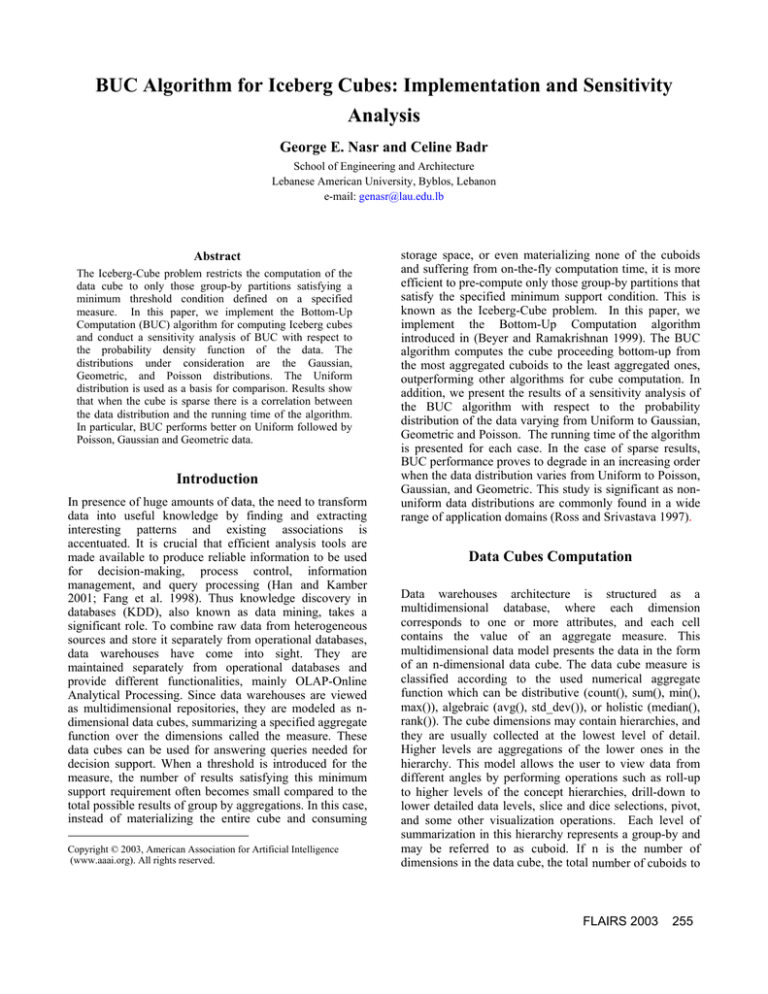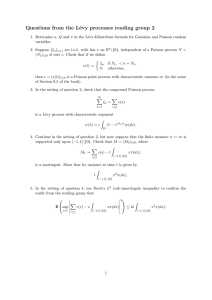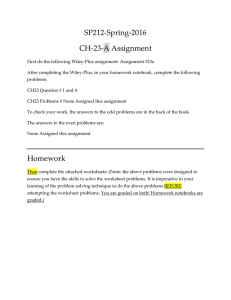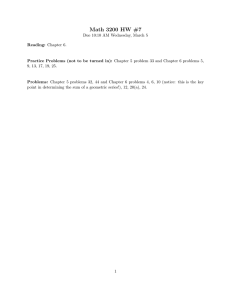
BUC Algorithm for Iceberg Cubes: Implementation and Sensitivity
Analysis
George E. Nasr and Celine Badr
School of Engineering and Architecture
Lebanese American University, Byblos, Lebanon
e-mail: genasr@lau.edu.lb
Abstract
The Iceberg-Cube problem restricts the computation of the
data cube to only those group-by partitions satisfying a
minimum threshold condition defined on a specified
measure. In this paper, we implement the Bottom-Up
Computation (BUC) algorithm for computing Iceberg cubes
and conduct a sensitivity analysis of BUC with respect to
the probability density function of the data. The
distributions under consideration are the Gaussian,
Geometric, and Poisson distributions. The Uniform
distribution is used as a basis for comparison. Results show
that when the cube is sparse there is a correlation between
the data distribution and the running time of the algorithm.
In particular, BUC performs better on Uniform followed by
Poisson, Gaussian and Geometric data.
Introduction
In presence of huge amounts of data, the need to transform
data into useful knowledge by finding and extracting
interesting patterns and existing associations is
accentuated. It is crucial that efficient analysis tools are
made available to produce reliable information to be used
for decision-making, process control, information
management, and query processing (Han and Kamber
2001; Fang et al. 1998). Thus knowledge discovery in
databases (KDD), also known as data mining, takes a
significant role. To combine raw data from heterogeneous
sources and store it separately from operational databases,
data warehouses have come into sight. They are
maintained separately from operational databases and
provide different functionalities, mainly OLAP-Online
Analytical Processing. Since data warehouses are viewed
as multidimensional repositories, they are modeled as ndimensional data cubes, summarizing a specified aggregate
function over the dimensions called the measure. These
data cubes can be used for answering queries needed for
decision support. When a threshold is introduced for the
measure, the number of results satisfying this minimum
support requirement often becomes small compared to the
total possible results of group by aggregations. In this case,
instead of materializing the entire cube and consuming
Copyright © 2003, American Association for Artificial Intelligence
(www.aaai.org). All rights reserved.
storage space, or even materializing none of the cuboids
and suffering from on-the-fly computation time, it is more
efficient to pre-compute only those group-by partitions that
satisfy the specified minimum support condition. This is
known as the Iceberg-Cube problem. In this paper, we
implement the Bottom-Up Computation algorithm
introduced in (Beyer and Ramakrishnan 1999). The BUC
algorithm computes the cube proceeding bottom-up from
the most aggregated cuboids to the least aggregated ones,
outperforming other algorithms for cube computation. In
addition, we present the results of a sensitivity analysis of
the BUC algorithm with respect to the probability
distribution of the data varying from Uniform to Gaussian,
Geometric and Poisson. The running time of the algorithm
is presented for each case. In the case of sparse results,
BUC performance proves to degrade in an increasing order
when the data distribution varies from Uniform to Poisson,
Gaussian, and Geometric. This study is significant as nonuniform data distributions are commonly found in a wide
range of application domains (Ross and Srivastava 1997).
Data Cubes Computation
Data warehouses architecture is structured as a
multidimensional database, where each dimension
corresponds to one or more attributes, and each cell
contains the value of an aggregate measure. This
multidimensional data model presents the data in the form
of an n-dimensional data cube. The data cube measure is
classified according to the used numerical aggregate
function which can be distributive (count(), sum(), min(),
max()), algebraic (avg(), std_dev()), or holistic (median(),
rank()). The cube dimensions may contain hierarchies, and
they are usually collected at the lowest level of detail.
Higher levels are aggregations of the lower ones in the
hierarchy. This model allows the user to view data from
different angles by performing operations such as roll-up
to higher levels of the concept hierarchies, drill-down to
lower detailed data levels, slice and dice selections, pivot,
and some other visualization operations. Each level of
summarization in this hierarchy represents a group-by and
may be referred to as cuboid. If n is the number of
dimensions in the data cube, the total number of cuboids to
FLAIRS 2003
255
be computed is 2n. This formula applies when there are no
hierarchies associated with each dimension. On the other
hand, when dimensions have hierarchies, that is, they are
based on abstraction, the total number of cuboids becomes
Nc = Π [i=1 to n] (Li + 1), where Li is the number of levels
of the ith dimension. This means that the number of
cuboids grows significantly as n increases, making it
impractical to compute them all. Consequently, in order to
provide fast response time to OLAP queries, and to avoid
huge storage requirements, it is crucial to select a proper
subset of the possible cuboids to be precomputed. This is
known as partial materialization (Han and Kamber 2001).
Iceberg Cubes
Often in OLAP queries, a minimum support is introduced
as a measure of the interestingness of the results. For
example, when the aggregate measure is Count(), the
minimum support is the minimum number of tuples in
which a combination of attribute values must appear to be
considered frequent.
When a threshold is introduced for the aggregate measure,
the number of results having a value above the minimum
support is often very small relative the large amount of
input data, as compared to the tip of an iceberg. In this
case, the group by is described as sparse because the
number of possible partitions in it is large relatively to the
number of partitions that actually satisfy the abovethreshold condition. When the number of sparse group
by’s becomes a high percentage of the total number of
group by’s, the cube is categorized as sparse. In this case,
it is preferable to compute the Iceberg cube that holds only
the partitions where the cells measure evaluates to an
above-threshold value.
The SQL statement of a typical Iceberg-Cube for a threedimensional data cube is expressed in (Beyer and
Ramakrishnan 1999) as:
SELECT A, B, C, COUNT (*), SUM (X)
FROM R
CUBE BY A, B, C
HAVING COUNT (*) >= minsup,
where minsup is the value of required minimum support.
In distributive cubes, it is possible to take advantage of the
fact that higher-level granularities are computed from
lower-level ones. That is, if at the more aggregated group
by the Count does not evaluate to a value greater than
minimum support, then it is subsequent that the less
aggregated group by’s will not either making it possible to
skip the computation for those higher levels. This process
constitutes the basis for the algorithms tackling the
Iceberg-Cube problem. Since real-time data is frequently
sparse (Ross and Srivastava 1997), the importance of those
algorithms increases with their efficiency in computing
sparse datacubes.
256
FLAIRS 2003
Bottom-Up Computation Algorithm
Kevin Beyer and Raghu Ramakrishnan have proposed an
algorithm, BottomUpCube (BUC), that computes sparse
and Iceberg cubes (Beyer and Ramakrishnan 1999). Their
algorithm is inspired by previous ones presented in (Ross
and Srivastava 1997), and combines partitioning to
pruning for more efficiency. BUC performance analysis
proved to be notably faster than its closest competitors.
Also, BUC, which has been limited to simple measures,
such as Count or Sum, was extended in (Han et al. 2001)
to compute Iceberg cubes with complex measures like
Average.
Figure 1 shows the processing tree of BUC for three
dimensions. As illustrated, BUC begins the cube
computation from the most aggregated group-bys up to the
less aggregated one, as opposed to other cube algorithms.
It is a recursive algorithm that takes advantage of
minimum support pruning since it avoids recursion to
lower levels of aggregation (i.e., higher levels in the
processing tree) if the minsup condition is not satisfied at
the current level.
Figure 1: BUC Processing Tree
As a first step, BUC takes the entire input and aggregates it
to evaluate the specified measure, Count for instance. If
the value meets the threshold condition, BUC considers the
first attribute dimension A. The input is then ordered by A,
and partitioned to obtain the count of each distinct value of
A. In the case where the count of a specific attribute value
x is above minsup, x is considered to be frequent and
outputted to the results. It follows that the tuples
containing x in the first attribute of the input relation are
further examined by BUC. Those tuples constitute the new
input to the recursive call of BUC; ordering and
partitioning are next done on the following dimension, B.
Similarly, only the tuples containing frequent attribute
values of B in the current input are processed in a new
recursive call on dimension C. Along the recursive
process, the frequent combinations found are sent to
output. When all attribute values are considered in the last
dimension, the algorithm recurses back to the previous
level, and considers the next attribute value of B. Also,
when all attribute values of B are considered, BUC
recurses back to dimension A to examine the next attribute
value of A. Finally, when no more frequent counts can be
found, the algorithm returns and all frequent combinations
are in the output relation.
BUC Implementation
With its dynamic selection BUC has proven to outperform
all previous algorithms elaborated for Iceberg Cube
computation. However, since its performance is not
optimal when the data is non-uniform, and since real-world
applications data is often non-uniform, this work aims at
investigating BUC performance in the case of dimensions
having different non-uniform distributions. In particular,
data having Gaussian, Geometric or Poisson distribution
are examined as compared to the Uniform distribution.
To test the performance of the BUC algorithm, many
factors are taken into consideration. This study considers
computing Iceberg Cubes of three dimensions with respect
to one measure, the monotonically decreasing distributive
aggregate function Count. The variable parameters of
interest are the input data size, the cardinality of the
dimensions, the minimum support value chosen and the
distribution of the input data.
This study is conducted on a large number of numerical
tuples, obtained from pseudo-random generating classes.
To generate the test data, we used the Colt 1.0.2 package
provided by the Open Source Libraries for High
Performance Scientific and Technical Computing in Java
of CERN institute. The classes needed for generating
Uniform, Gaussian, Geometric, and Poisson distributions
were selected and customized in order to obtain the needed
data in the appropriate format. The input consists of flat
files of integer numbers with the respective statistical
distributions. The size of the data varied from 5000
numbers, to 10000, 25000, and 50000 numbers. For each
input size and distribution, we generated files with
cardinalities of 25, 100, and 500. Moreover, an additional
java class was implemented to read from these files and
populate the database relations. Each test case was formed
by reading integers from 3 uncorrelated files of equal size,
equal cardinality, and similar distribution, and inserting
them simultaneously into the 3 dimensions of the input
relation to BUC.
The original BUC algorithm is given in (Beyer and
Ramakrishnan 1999). For our implementation, we adopted
a detailed variant of the algorithm inspired by (Findlater
and Hamilton 2001) as listed in Figure 2. BUC algorithm
was implemented using Java Language, compiled under
JBuilder 7.0. Java Database Connection was used to access
the database relations stored on an Oracle 9i local database
server. In order to have in-memory processing of relations,
we used the CachedRowSet class since it does not
maintain an open connection to the database and stores
data completely in memory. External partitioning was not
needed since test input could be entirely placed in main
memory.
In this investigation, experiments were conducted on a
dedicated Pentium 4 computer, with CPU speed of 1500
MHz, and 512 MB RAM. The reported values represent
the average of values collected over multiple test runs on
identical data.
Class BUC(inputRelation, dim, startingAttr)
level = level + 1
newTable = "temptable" + dim
for d = dim to numDims
curTable = Run ("select * from " + inputRelation +
" order by " + fields[d])
if curTable.TupleCount <= 1 then return end if
C = cardinality[d]
dataCount = partition(inputRelation, d, C)
k=0
for i = 0 to C - 1
count = dataCount[i + 1]
if count >= minsup then
if level = 1 then startingAttr = d end if
strTemp = curTable[k, startingAttr]
for j = d - level + 2 to d
strTemp = strTemp + "-" + curTable[k, j]
end for
Run ("insert into Results (Combination, Count)
values (" + strTemp + "," + count + ")"
Run ("select into " + newTable + " from " +
inputRelation + " where " + fields[d] + " = " +
curTable[k,d]
ret_val = BUC(newTable, d + 1, startingAttr)
end if
k = k + count
end for
end for
Run ("drop table " + newTable)
level = level – 1
return
Function partition(inputRelation, d, C)
int count[C]
strGroup = fields[d]
newTable = "temptable" + d
Run ("select " + strGroup + ", count(*) as Count into
" + newTable + " from " + inputRelation + " group by
" + strGroup)
for i = 0 to newTable.RecordCount - 1
count[i + 1] = newTable [i, newTable.FieldCount - 1]
end for
count[0] = d
return count
Figure 2: BUC Algorithm
FLAIRS 2003
257
350
300
250
200
Uniform
Gaussian
150
100
50
0
Poisson
Geometric
5000
10000
25000
50000
Nb of Tuples
Figure 5: Running Time for Card = 500 and Minsup = 50
200
Time (sec)
The running time of the algorithm was recorded in each
test. The average values computed are presented in
graphical format. Figures 3, 4, and 5 depict time
measurements for a minimum support value of 50. Figures
6, 7, and 8 give the results for a minimum support of 100
whereas Figures 9, 10, and 11 show the results for a
minimum support of 500. Each set of figures illustrates the
execution times of three test cases where the dimensions
cardinality is 25, 100, and 500, respectively. The values on
the x-axis represent the size of the sample data, in
thousands of tuples. The y-axis values represent the time.
Actual measurements were taken in milliseconds. For
clarity of the plots, the values are converted to seconds.
The values for the four different data distributions are
plotted simultaneously on each graph. As seen in the plots,
the only constant general conclusion that can be made is
that the performance of BUC is similar for the Gaussian
and Poisson distributions. On the other hand, in the case
where minsup is 500 the results are sparse for all
considered distributions. Moreover, these results clearly
show that BUC performs best for Uniform data distribution
while exhibiting increasing performance degradation for
the Poisson, Gaussian, and Geometric distributions
respectively.
Time (sec)
Performance Results
Uniform
150
Gaussian
100
Poisson
50
Geometric
0
5000
10000
25000
50000
350
300
250
200
150
100
50
0
Uniform
Figure 6: Running Time for Card = 25 and Minsup = 100
Gaussian
200
Poisson
Geometric
5000
10000
25000
50000
Nb of Tuples
Time (sec)
Time (sec)
Nb of Tuples
150
Uniform
Gaussian
100
Poisson
50
Geometric
0
Figure 3: Running Time for Card = 25 and Minsup = 50
5000
10000 25000 50000
Nb of Tuples
Time (sec)
200
Figure 7: Running Time for Card = 100 and Minsup = 100
150
Uniform
Gaussian
100
Poisson
50
Geometric
0
5000
10000
25000
50000
Nb of Tuples
Figure 4: Running Time for Card = 100 and Minsup = 50
258
FLAIRS 2003
Time (sec)
350
300
Uniform
250
200
150
100
Poisson
Geometric
50
0
5000
10000
25000
50000
Nb of Tuples
Figure 8: : Running Time for Card = 500 and Minsup = 100
120
100
Time (sec)
Conclusion
Gaussian
Uniform
80
Gaussian
60
Poisson
40
Geometric
20
0
5000
10000
25000
In this paper, the Bottom-Up Computation algorithm is
implemented on Iceberg cubes of three dimensions using
the monotonically decreasing distributive aggregate
function Count. The performance of the BUC algorithm on
non-uniform data is investigated. In particular, algorithm
behavior on data having Gaussian, Geometric or Poisson
distribution is examined as compared to its performance on
data with Uniform distribution. Results show that there is
a correlation between the data distribution and the running
time of the algorithm. In the case of sparse cube, BUC
performance proves to degrade in an increasing order
when the data distribution varies from Uniform to Poisson,
Gaussian, and Geometric. Moreover, testing results using
different values for the size of input data, the cardinality of
dimensions and the required minimum support are
included.
References
50000
Beyer, K. and Ramakrishnan, R. 1999. Bottom-Up
Computation of Sparse and Iceberg CUBEs. SIGMOD
Record 28(2): 359-370.
Nb of tuples
Figure 9: Running Time for Card = 25 and Minsup = 500
120
Time (sec)
100
Unifo rm
80
Gaussian
60
Poisson
40
Geometric
20
0
5000
10000
25000
Findlater, L. and Hamilton, H. J. 2001. An Empirical
Comparison of Methods for Iceberg-CUBE Construction.
In Proceedings of the 14th International FLAIRS
Conference, 244-248. Menlo Park, Calif: AAAI Press.
50000
Nb of tuples
Figure 10: Running Time for Card = 100 and Minsup = 500
Time (sec)
Fang, M., Shivakumar, N., Garcia-Molina, H., Motwani,
R. and Ullman, J.D. 1998. Computing Iceberg Queries
Efficiently. In Proceedings of the 24th VLDB Conference,
299-310. New York.
80
70
60
50
40
30
20
10
0
Uniform
Han, J., and Kamber, M. 2001. Data Mining Concepts and
Techniques. 1 – 99: Academic Press. Morgan Kaufmann
Publishers.
Han, J., Pei, J., Dong, G. and Wang, K. 2001. Efficient
Computation of Iceberg Cubes with Complex Measures. In
Proceedings of ACM-SIGMOD International Conference
on Management of Data, 1-12. Santa Barbara, Calif.
Gaussian
Poisson
Geometric
5000
10000
25000
Ross, K.A., and Srivastava D. 1997. Fast Computation of
Sparse Datacubes. In Proceedings of the 23rd VLDB
Conference, 116-125. Athens, Greece.
50000
Nb of tuples
Figure 11: Running Time for Card = 500 and Minsup = 500
FLAIRS 2003
259




